The Dakar Rally has a well-earned reputation as one of the world’s toughest motorsport events. From its origins in 1978 as an off-road race from Paris, France to Dakar, Senegal, on the west coast of Africa, through various iterations across Europe and Africa and a decade-long decampment to South America, the rally has retained a sense of adventure — and danger — as hundreds of cars, motorbikes, trucks and quads venture into unforgiving environments amid one of the toughest tests of human and machine endurance. In any given year, as many as half the entrants won’t finish the race.
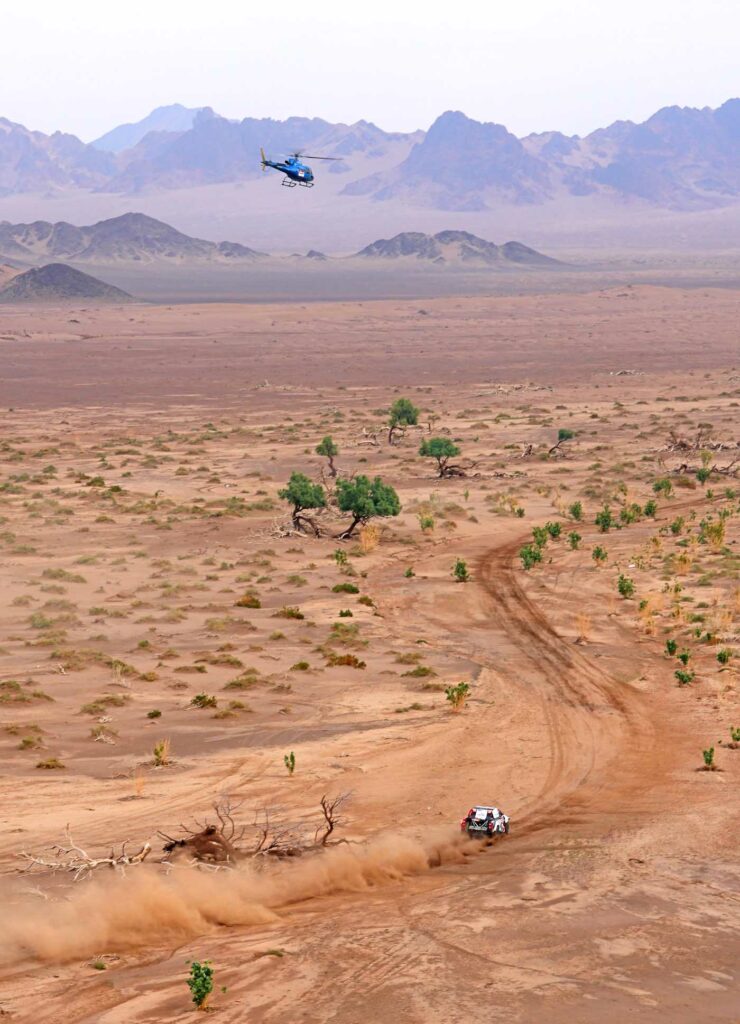
Since 2020, the rally has been held in Saudi Arabia. That year’s event also saw The Helicopter and Jet Company (THC) provide its first coverage of the rally — on a small scale, and with support. This year, THC was responsible for all helicopter support for Dakar, and THC invited Vertical along for the ride.
Backed by the Public Investment Fund (PIF) of Saudi Arabia, THC was established in 2018 with the aim of contributing to Saudi Vision 2030 — the Kingdom’s plan to diversify its economy and develop public service sectors.
The company’s first helicopter arrived at the end of 2019, but by the end of 2022, its fleet had grown to include 14 Leonardo AW139s, 10 H125s, and five H145s.
THC’s operations cover the spectrum, from tourism to aerial work, search-and-rescue, medevac, VVIP transportation — and aerial filming. In addition to working on the Dakar Rally for the last four years, it provides aerial support for the Saudi Arabian Formula One Grand Prix, and has worked on National Geographic documentaries and a Hollywood movie.
The company’s work on a prestigious event like the Dakar Rally shows how far the company has come in such a short time, Arnaud Martinez, THC’s chief executive officer told Vertical. “It shows that, while the company is growing quickly, it’s certainly not learning on the job. We’ve imported talent and we’re growing talent, not just for operations and maintenance, but for safety and quality. It’s also important to show to our owners and to the Saudi people that helicopters have a place here.”

THC had a team of 42 working on the race, from pilots to maintenance technicians and those working to support them in the field. In terms of aircraft, it had 13 Airbus H125s (five subcontracted from Hélicoptères de France) and one Airbus H145 D3 dedicated to race support in various roles. Three worked for race direction, four provided medevacs, four were used for filming, two for VIP transport, and one for press and photographers.
The H145 D3 was used in a medevac role, and it presented a new night capability, offering further protection for any racers that didn’t make it to the end of the stage by dusk — which fell around 5:30 p.m.
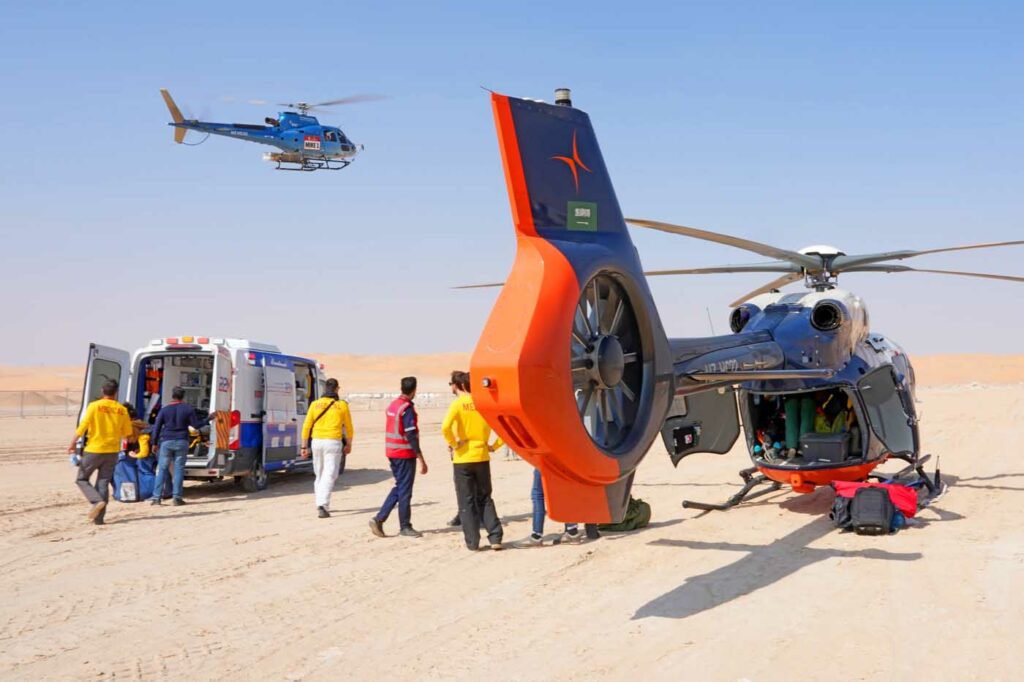
“Everybody was just thrilled [with THC’s support] this year,” said Martinez. “One of the big things was the introduction of the 145 to give them a twin-engine night-capable medevac, and it was involved in a couple of genuine lifesaving events.”
Comprehensive support
The Dakar route changes each time the event is held, and this year’s course was designed to be even tougher than the last edition.
The route crossed Saudi Arabia, beginning on the shores of the Red Sea on the country’s west coast and travelling northeast to the city of Ha’il. It then took competitors southeast to Riyadh. From there, racers travelled across the country’s enormous Eastern Province, spending four gruelling days moving through the desolate expanse of the “Empty Quarter” — a vast sand desert with dunes that can reach 700 meters high with 60-degree slopes. The course then headed north, wrapping up in Dammam on the coast of the Arabian Gulf.
All told, the route spanned over 3,100 miles (5,000 kilometers), with racers completing an average of 370 miles (600 kilometers) each day.
The race took in some spectacular scenery — from the crystal clear blue waters and white sandy beaches running alongside Saudi Arabia’s west coast, the Martian-like landscape of the mountainous rocky north, through the forests of the Qassim Province in the heart of the country, to the desert expanse of the Empty Quarter.
“The flying is actually pretty thrilling, as moving through the different scenery is fantastic,” said Martinez. “During the missions — filming is a big adrenaline rush, obviously; race direction and VIP is relatively stable, as you’re following it around, taking people in close sometimes; while the medevac aircraft aren’t normally in the air.”
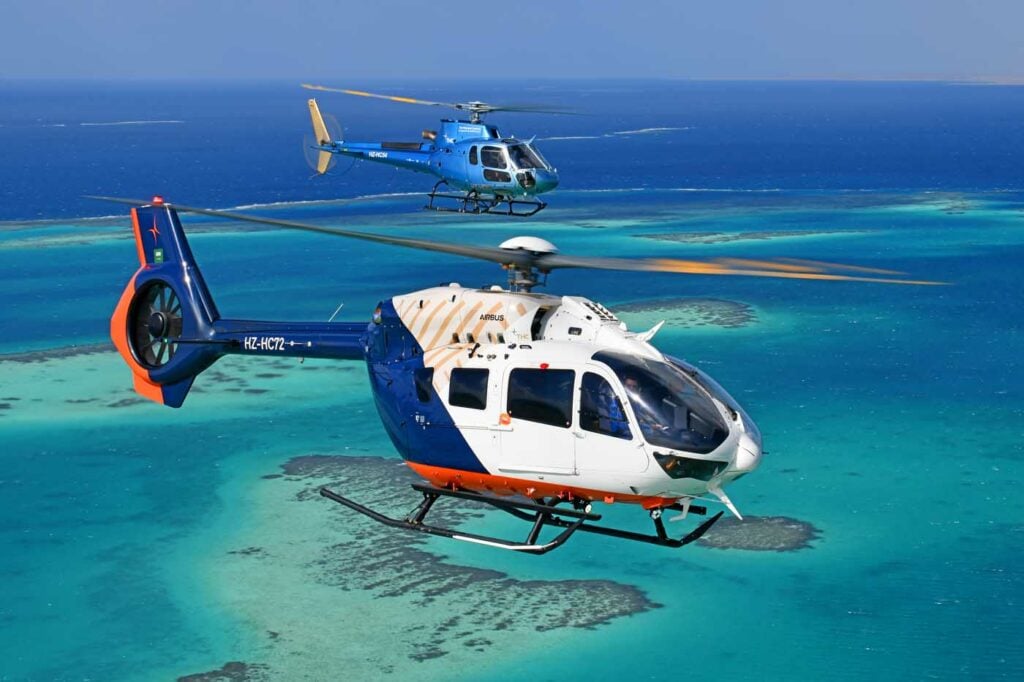
The aircraft assigned to race direction were carrying the race director, a race marshal, one or two journalists and a doctor. In addition to making sure the competitors were hitting the required checkpoints during the race — and not disappearing too far in the wrong direction, these aircraft would bring the equipment to create the check points.
Gilles Plaisance is general manager of rotorcraft for THC, and was assigned as director of helicopter operations at Dakar with overall responsibility for the 14 rotary-wing aircraft working on the event. A former helicopter pilot in the French Navy, he has worked in Saudi Arabia for the last seven years.
During the race, Plaisance was one of the pilots flying the race director aircraft. As with all the aircraft crews working on the rally, he said he had an early start each day — a 4:45 a.m. wakeup to be ready for a takeoff at sunrise.
The aircraft would follow the lead of the race unless they were specifically requested to do otherwise (such as to follow specific competitors or supervise the response to accidents near the race’s head). They could also be used to guide lost competitors by lighting the way forward for them, and were equipped with a cargo swing to be able to remove damaged motorbikes near the race’s head.
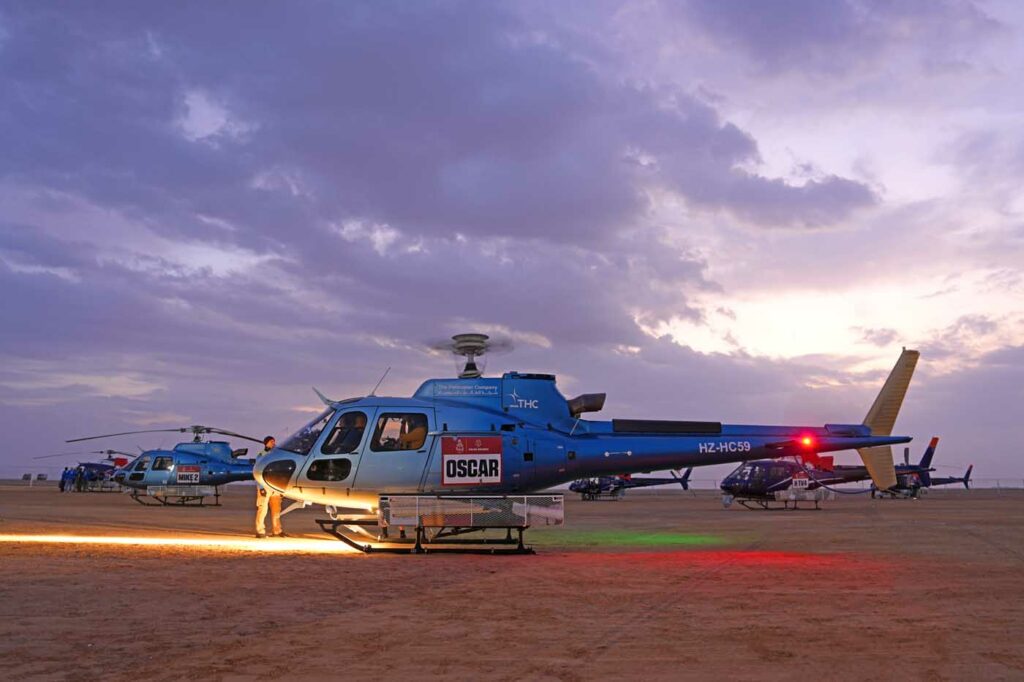
Plaisance said the H125 was particularly well-suited to supporting the rally.
“The H125 is probably the most suited helicopter in the world combining all the qualities for this kind of event and in such conditions — it’s powerful, easy to maintain, has efficient sand filters, and modern avionics.”
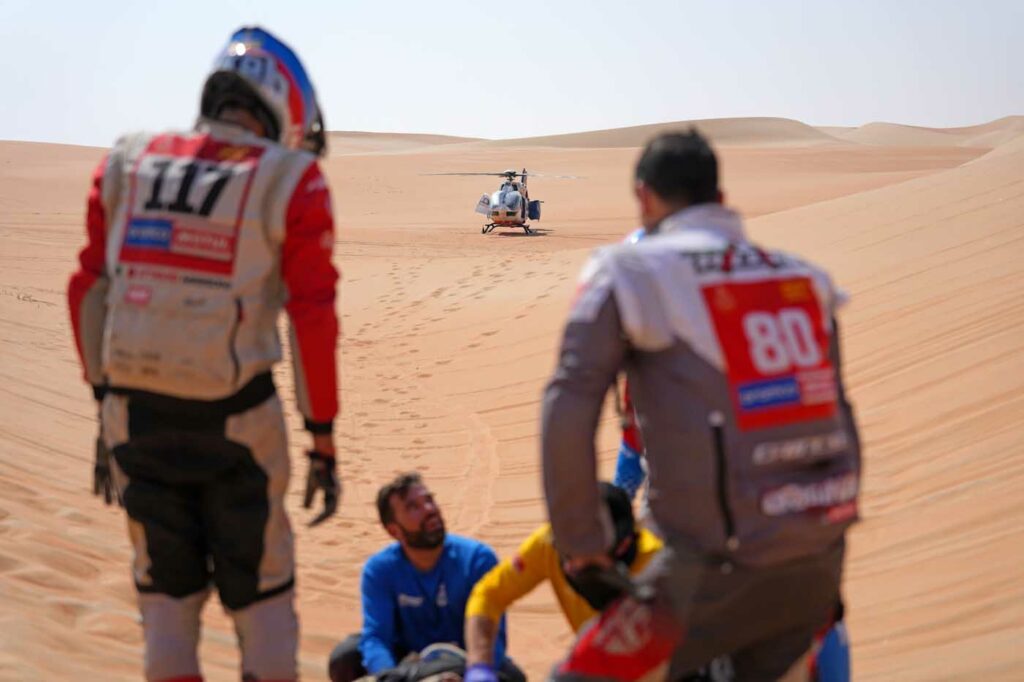
He said the aircraft’s payload capacity allowed the team to use an external basket to store all mission equipment while having three or four passengers — and still had the capability to sling a motorbike or quad weighing between 330 lb. and 880 lb. (150 kg and 400 kg).
The aircraft used for filming had a camera operator’s station in the cabin, and were equipped with either a GSS camera or a Cineflex system (there were two of each). Fixed-wing aircraft flew in a pattern overhead to uplink the video.
The filming aircraft each had a different role: one was assigned to cover the lead cars, another to film the lead motorbikes, another to follow private clients or racers, and the fourth to film the back of the race and the trucks. They flew as close as they could to the cars to get the best shots possible.
The medevac aircraft were typically following one of the race groups, and coordinated with each other to ensure that there was always a machine nearby to any group of racers. During the day they would leapfrog, positioning forward and then waiting until the last of the competitors had gone past before moving forward again. If any particularly dangerous areas were identified as the race progressed, an aircraft would be placed nearby.
The helicopters would, of course, need to refuel during the day. Fuel trucks were positioned at strategic locations, and the helicopters would rotate off to refuel.
“It’s just a constant moving machine,” said Plaisance. “They would figure out a routine and cycle through: who’s getting fuel, who’s on the ground, and who’s moving to where.”
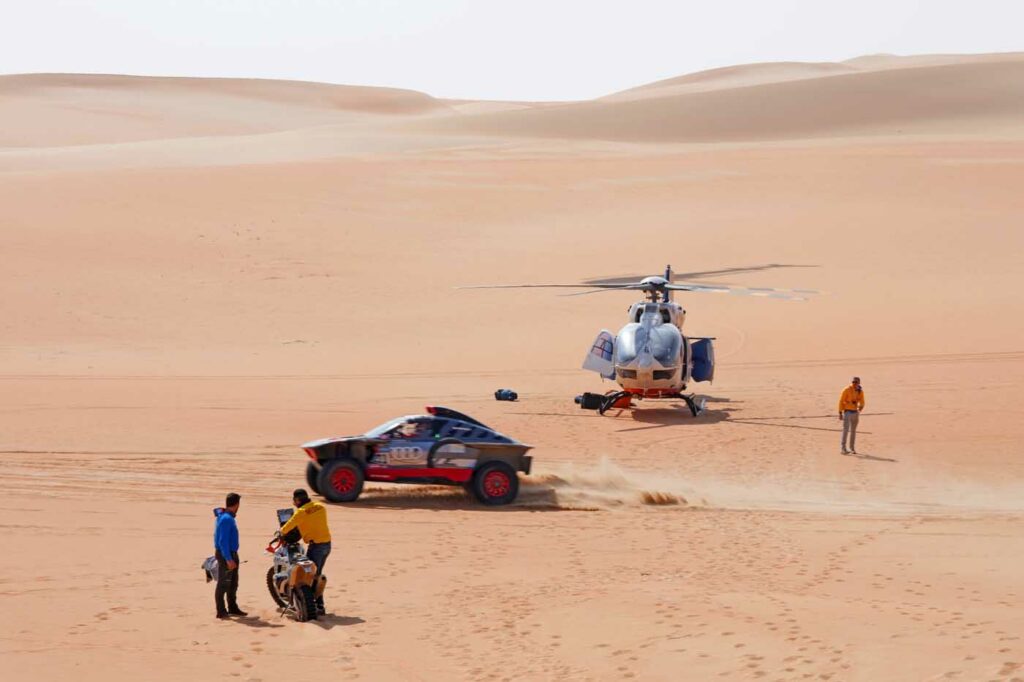
Stephani Scheepers flew in the medevac role with one of THC’s H125s. “Some days you can stay in one position for many hours without moving, but most of the time you are following along with the race as the competitors progress,” she said. “We always carry our camping equipment with us — as well as necessary food and water provisions — in case we need to sleep in the field, depending on the circumstances of the day.”
Abraham Le Roux, pilot who flew the H145 during the rally, highlighted the endurance required to handle the long work days.
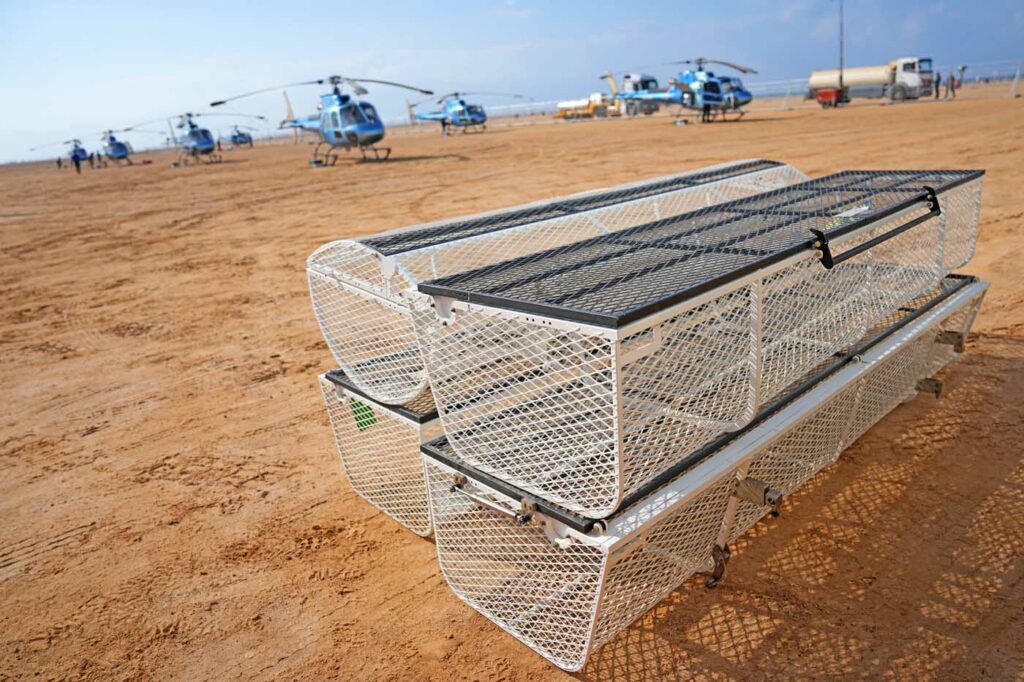

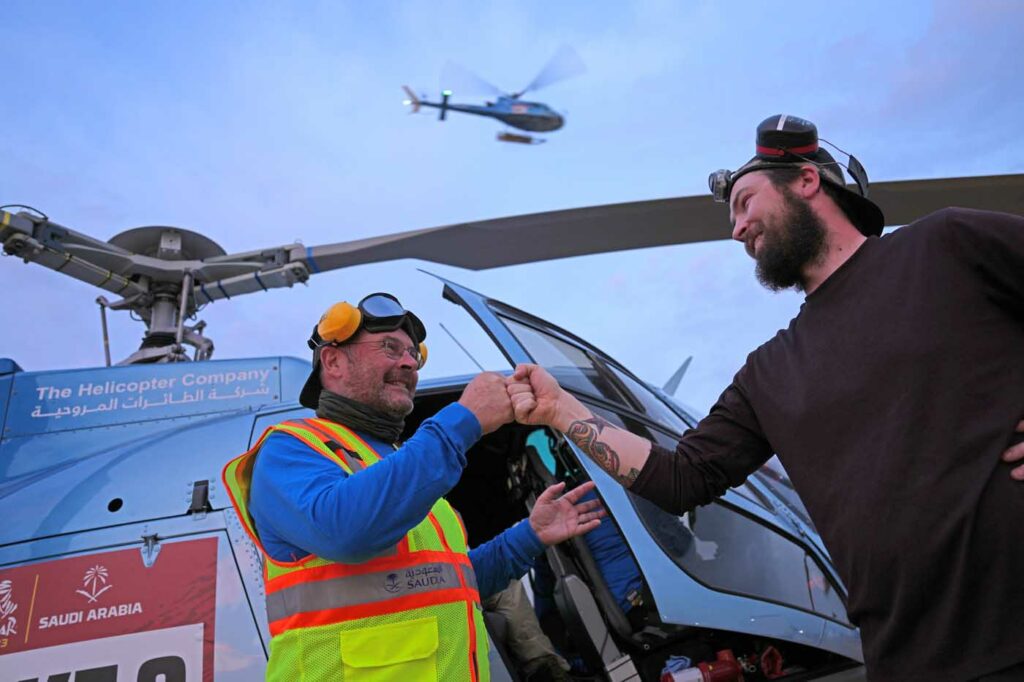
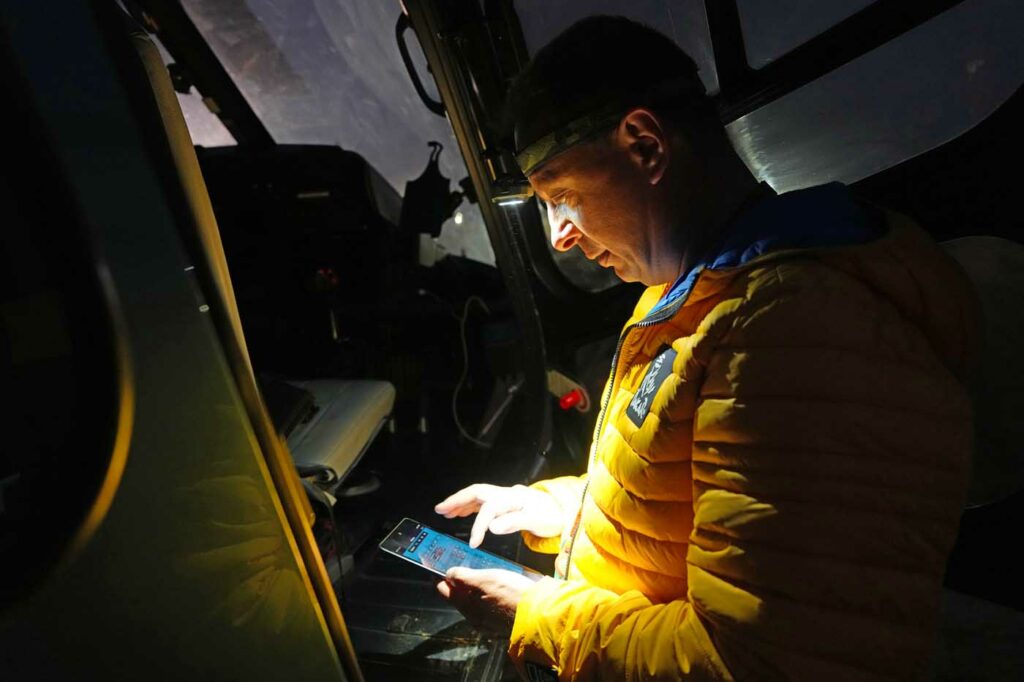

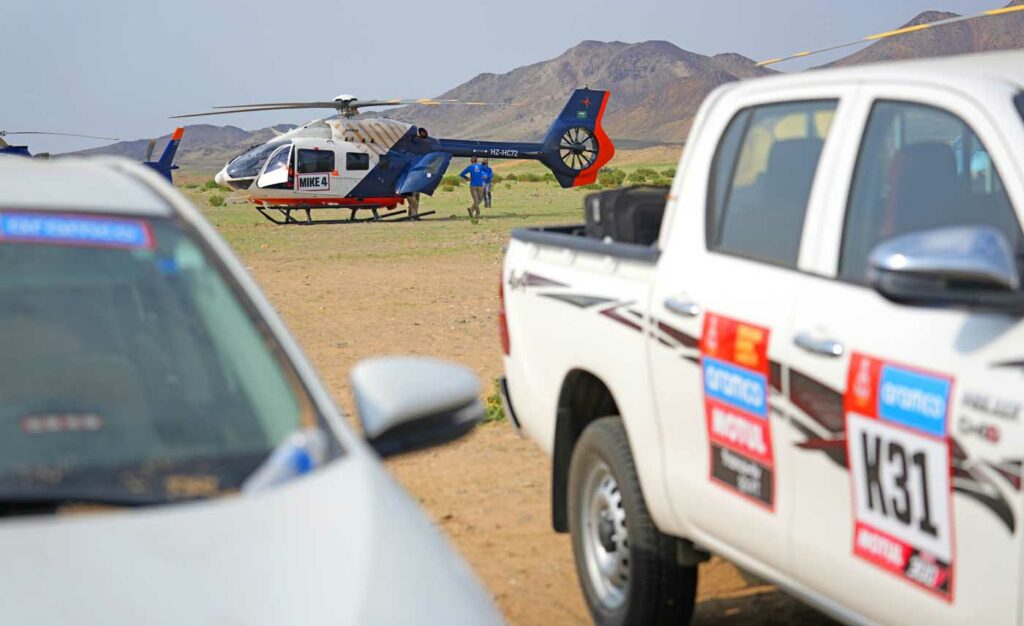
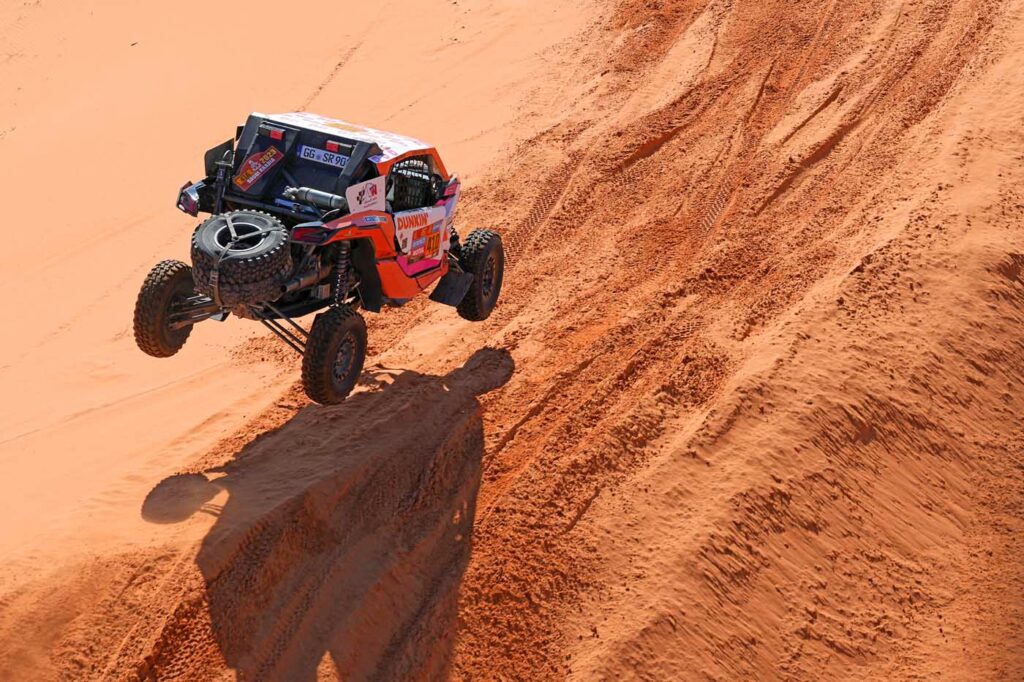
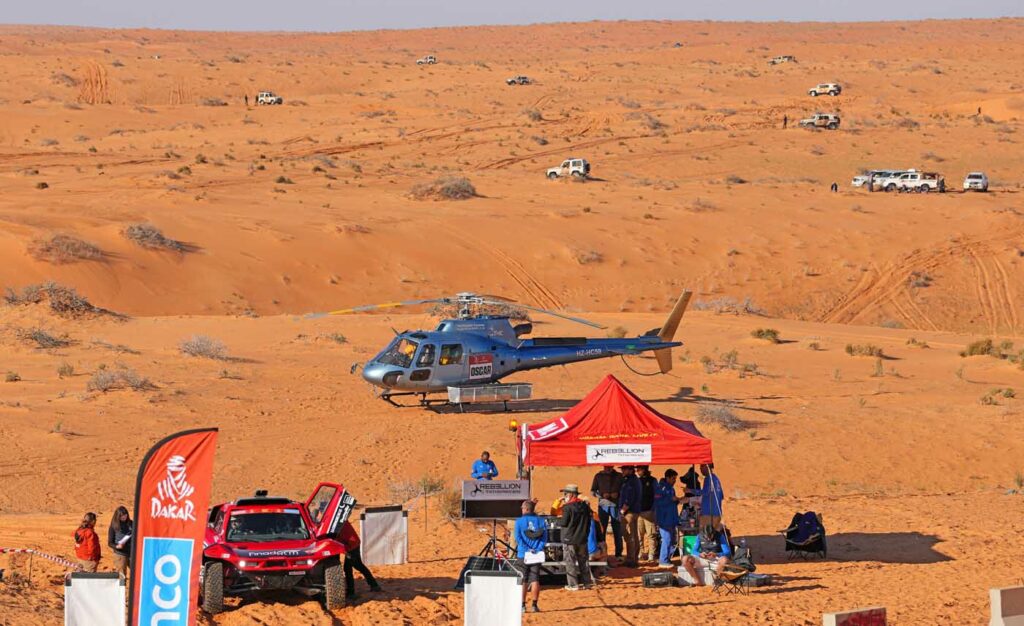
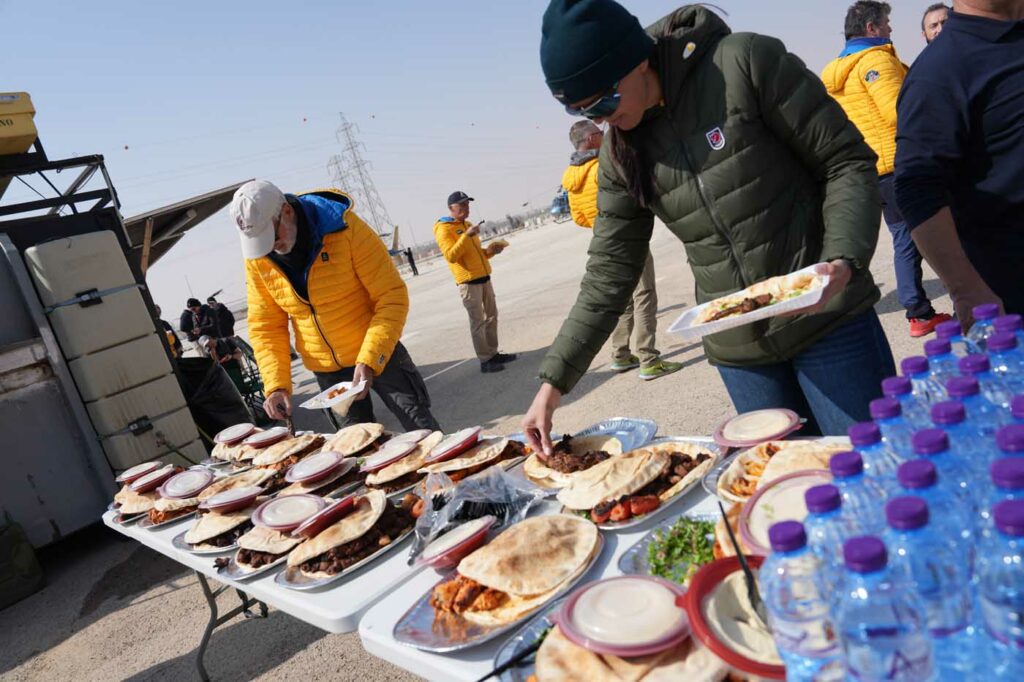
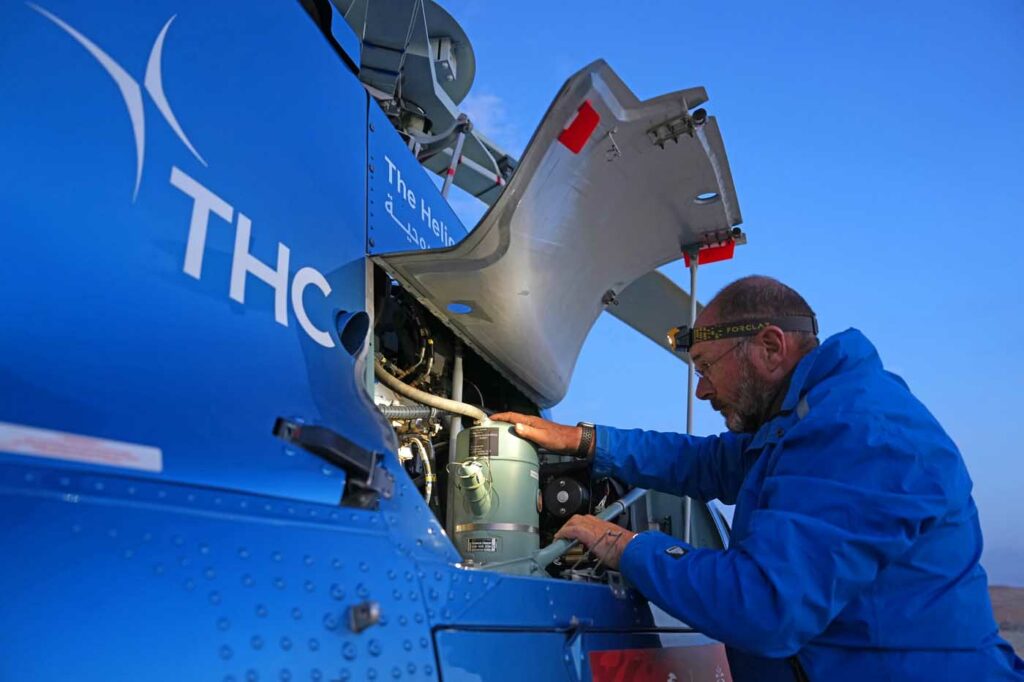
“Participating in the rally comes with the expectation of early mornings and late nights,” he said. “The biggest challenge we faced during an event like this was fatigue management. The pace was relentless, with no respite until the stage was over and everyone safely back. The physical demands of the job and the need to remain vigilant at all times meant that good crew resource management was critical to mission success.”
He also praised the “unparalleled situational awareness” provided by the H145 D3’s Helionix avionics system.
“The Advanced Flight Control System is rock solid and provides a very stable platform, allowing us to focus on the bigger picture, particularly at night when visibility is reduced,” he said. “In addition, the performance is outstanding, giving you confidence — particularly during dusty conditions where brownouts are a real danger.”
As with all operations involving multiple parties, communication was vital — but a clear division of airspace also helped make the work as safe as possible. The filming aircraft had priority up to a height of 390 feet (120 meters) — no other aircraft were allowed below that height. The medevac aircraft operated at heights between 590 and 850 feet (180 and 260 meters), but if a medevac was requested, that aircraft had priority and all the other aircraft would orbit at a higher altitude. The race director and VIP aircraft were flying above 980 feet (300 meters) the majority of the time.
“It’s busy, but the actual airspace is quite straightforward to manage,” said Plaisance.
A logistical puzzle
The biggest issue facing racers and those supporting them this year was inclement weather throughout the race.
“This year they had a double problem,” said Martinez. “They did the very challenging route, but they also had terrible weather.”
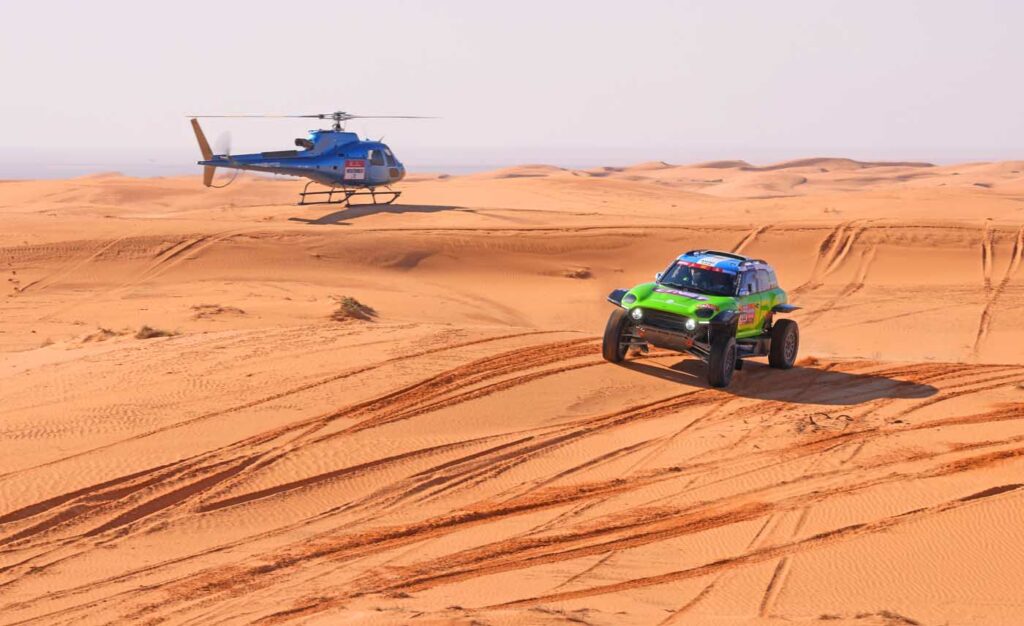
Torrential rain in the middle stages occasionally created instant impassable rivers and bogs that trapped cars up to their axles, while temperatures regularly dropped below zero in the mornings. There was even the hint of snow at times.
Plaisance said the conditions presented a challenge for the pilots, too.
“[We had] bad visibility, [a] low ceiling 70 percent of the time, and 30 percent in sand conditions with brownout and flat light experience within the Empty Quarter,” he said.
The logistics challenges were also significant. The support structure that enables the race to exist must be moved every day. At the end of each stage was a “bivouac” — a sprawling temporary base at which racers, their support crews and the race organizers and support staff could rest, perform any maintenance the cars (or aircraft) required, and eat. Between 2,500 to 3,000 people would gather there each day.
There were actually three bivouacs in existence: at any one time, one would be in use, one would be dismantled or travelling to a future staging point, and one would be getting set up for the next day’s stop.
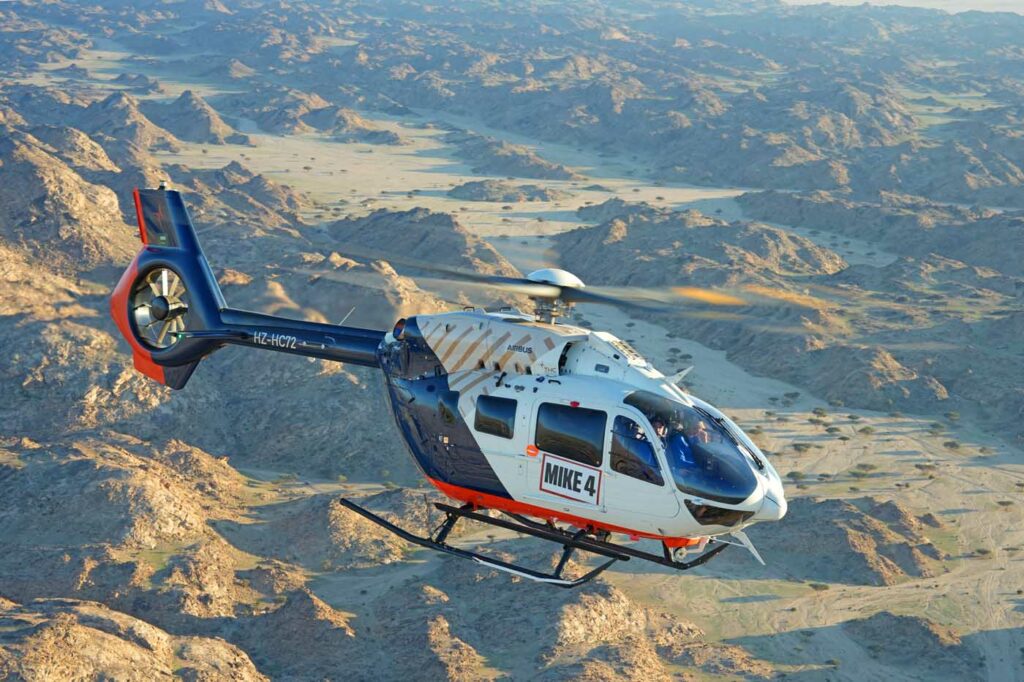
“It’s a logistics dream to watch,” said Plaisance. “If you want to see logistics in action, it is absolutely stunning.”
At the bivouac, THC’s maintenance team and support staff worked from a dedicated mobile workshop that was mounted on a truck, while another truck carried spare parts, tools, materials, and everything needed to support the fleet.
The workshop also contained several bunks that became “prime territory” as the rain began. “There was a lot of trading being done for the undercover bunk as opposed to a wet tent!” said Plaisance.
The maintenance team travelled from bivouac to bivouac either through hitching rides on aircraft as they moved from point to point, or on one of the ground transports provided by the organizers. THC also brought along its own 4×4 car that could be used to ferry mechanics to aircraft, if needed.
Maverick Millen worked as THC’s maintenance manager during Dakar. He said a typical day would involve waking up before dawn to perform pre-flight inspections on the aircraft. Maintenance planning and forecasting would take up the bulk of his day.
“The technicians stay on standby for incoming aircraft, while taking turns going for meals and observing some of the race teams in action,” said Millen. “Once the aircraft are down and clear for the day, our maintenance team springs into action with their assigned aircraft, having already been briefed on inspections to be carried out that night for the next day’s flight.”
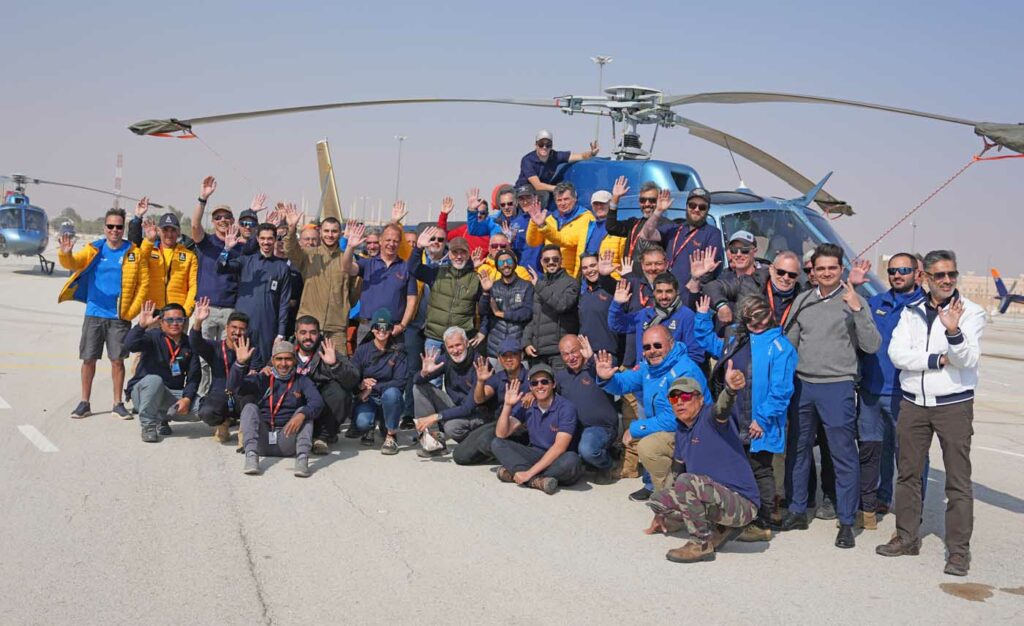
Typical maintenance involved replacing rotor blade sand protection tape, or dealing with any other snags or defects that might have become apparent during the day. Once the work was done and the paperwork completed, the maintenance team would be released for the night.
Millen said it took “a small army of professionals that are extremely dedicated to their individual position” to support the fleet during Dakar. “There are not only pilots and technicians — there are flight dispatchers, operations control, outstation logistics, business development, safety management, and multiple other department managers and post holders pulling late nights and early mornings to make this whole mission possible.”
A key part in this army of professionals was the Operational Control Center. Described by Martinez as “our mobile air traffic control,” the dedicated staff of the OCC performed all the flight planning and flight following of the Dakar helicopter fleet, and liaised with THC’s headquarters back in Riyadh.
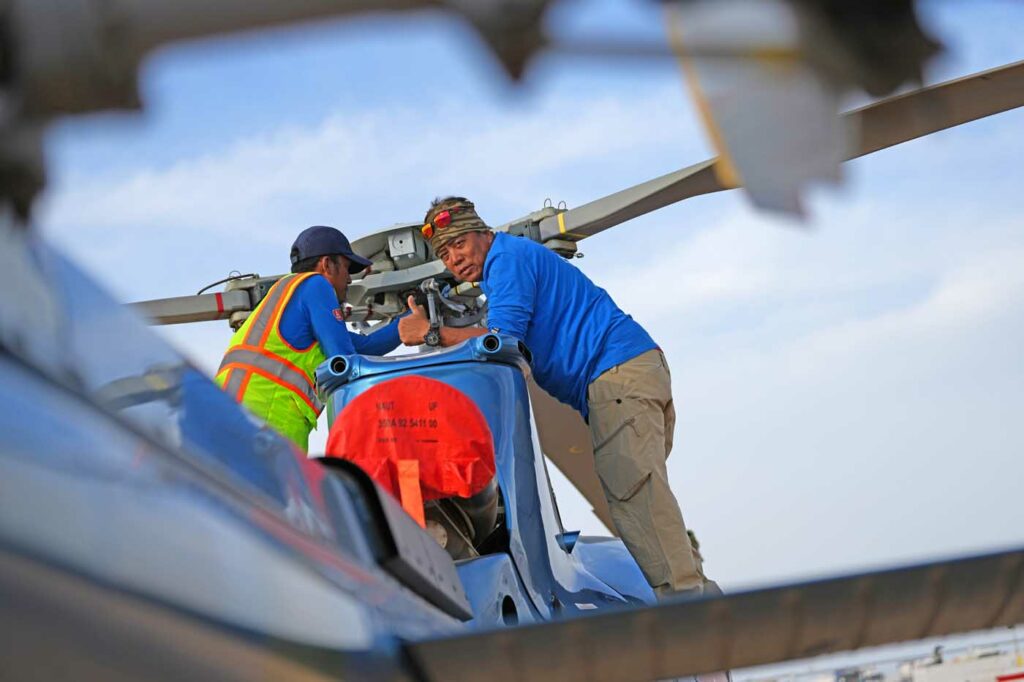
From THC’s perspective, the biggest challenge in putting the support structure together was getting such a large fleet of aircraft ready for deployment. The rally falls in the middle of the winter, which is the busiest time of year for THC (the heat of Saudi Arabian summers restricts operations), so the aircraft are typically in the midst of contracts across the country.
“We’ve got to pull them all in from other jobs almost at the last minute,” said Martinez. “We’ve then got to get them all prepared and ready, and then post-race, get them all back to base and back online again. We had 10 days to get all these aircraft refurbished, cleaned up and out the door again to go back to work around the Kingdom.”
Dakar is currently scheduled to remain in Saudi Arabia for at least the next four years. THC expects to be able to continue providing helicopter coverage for the event, but must rebid on the contract each year.
“This is a prestige contract for us,” said Martinez.
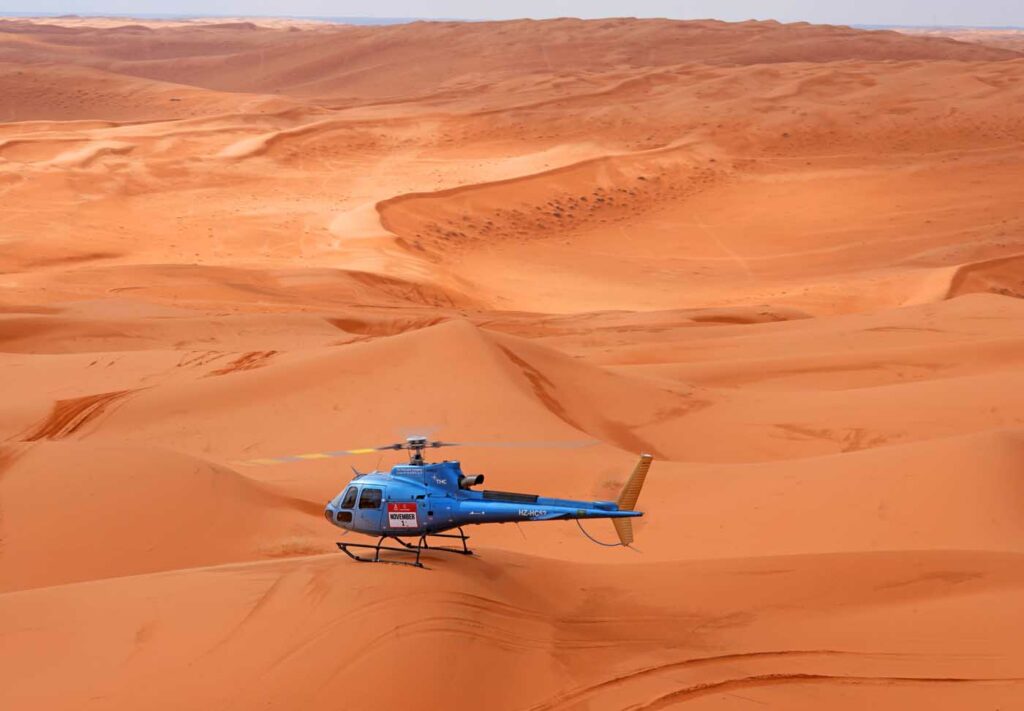
The rally serves as a key focus within THC, bringing the company together to figure out how they’re going to cover this marquee event.
“Dakar is used as a huge motivator for the company for the year ahead,” said Martinez. “Everybody was under pressure for it, as is always the case, but we delivered it well and delivered it safely.”





